Groups of cnidaria - Study guides, Revision notes & Summaries
Looking for the best study guides, study notes and summaries about Groups of cnidaria? On this page you'll find 28 study documents about Groups of cnidaria.
Page 3 out of 28 results
Sort by
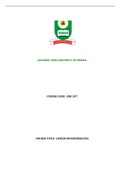
-
BIO 207
- Lecture notes • 69 pages • 2022
-
- £11.96
- + learn more
NATIONAL OPEN UNIVERSITY OF NIGERIA COURSE CODE : BIO 207 COURSE TITLE: LOWER INVERTEBRATES Course Code & Course Title: BIO 207: Lower Invertebrates Course Writer: Dr. Patrick A. Audu Course Editor Programme Leader Dr. Ado Baba Ahmed National Open University of Nigeria, Lagos Course Coordinator Mr. Adams, Abiodun E National Open Univers...
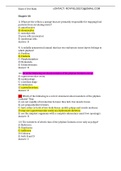
-
Exam 4 Test Bank
- Exam (elaborations) • 24 pages • 2022
-
- £8.37
- + learn more
1) What are the cells in a sponge that are primarily responsible for trapping food particles from circulating water? A) amoebocytes B) choanocytes C) mesohyl cells D) pore cells (porocytes) E) epidermal cells Answer: B 9) A radially symmetrical animal that has two embryonic tissue layers belongs to which phylum? A) Porifera B) Cnidaria C) Platyhelminthes D) Nematoda E) Echinodermata Answer: B 10) All of the following are characteristics of the phylum Cnidaria except A) a gastrovascular cavity. B...
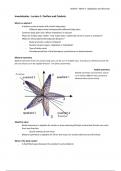
-
Invertebrates Lecture 1 notes - Porifera and Cnidaria
- Lecture notes • 5 pages • 2024
- Available in package deal
-
- £5.49
- + learn more
Detailed yet concise lecture notes covering the content from the first lecture of invertebrate zoology. These first class notes are easy to read, understand and learn from - with helpful diagrams. Topics are covered thoroughly including: - Bilateral and radial symmetry (with diagrams) - Body cavities (coelomates, pseudocoelomates and acoelomates - examples and diagrams) - Porifera (choanocytes) - Eumetazoa (groups of cnidaria, life cycles, body structures)
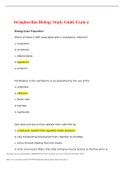
-
Straighterline Biology StudyGuide Exam a
- Exam (elaborations) • 13 pages • 2022
-
- £12.36
- + learn more
Straighterline Biology Study Guide Exam a Biology Exam Preparation Which of these is NOT associated with a roundworm infection? a. hookworm b. trichinosis c. elephantiasis d. tapeworm e. pinworm Fertilization in the earthworm is accomplished by the use of the a. nephridia. b. clitellum. c. flame cells. d. trachea. e. typhlosole. Sea stars and sea urchins operate their tube feet by a. a hydraulic system that regulates water pressure. b. ci...
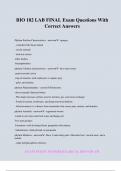
-
BIO 182 LAB FINAL Exam Questions With Correct Answers
- Exam (elaborations) • 8 pages • 2024
- Available in package deal
-
- £8.37
- + learn more
BIO 182 LAB FINAL Exam Questions With Correct Answers Phylum Porifera Characteristics - answer- sponges - considered the basal animal - sessile animals - lack true tissues -filter feeders -hermaphrodites phylum Cnidaria characteristics - answer- have true tissues -gastrovascular cavity -ring of tentacles with cnidocytes to capture prey - polys and medusa phylum Platyhelminthes - answerflatworms -dorsoventrally flattened bodies - Flat shape increases surface area for nutrient, gas, ...
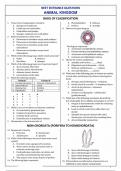
-
animal kingdom,animal classification,animal kingdom class 11,animal classification for kids,kingdom animalia,classification of animal kingdom,classification,kingdom animalia classification,animals,five kingdom classification,animal kingdom class 11 ncert,
- Summary • 6 pages • 2024
-
- £8.37
- + learn more
The animal kingdom is one of the major classifications in biological taxonomy, encompassing a vast diversity of organisms. Animals are typically categorized based on shared characteristics and evolutionary relationships. Here's a comprehensive overview of the animal kingdom classification: ### **Animal Kingdom Classification** #### **1. Domain and Kingdom** - **Domain**: Eukaryota - **Kingdom**: Animalia Animals are eukaryotic organisms, meaning their cells have a nucleus and other...
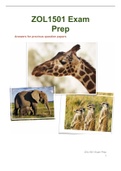
-
ZOL 1501 Exam Prep. Complete Solution 2023
- Exam (elaborations) • 22 pages • 2023
-
- £12.36
- + learn more
Learning Unit 1 Architectural patterns of Animals Five major grades of organization 1. Protoplasmic grade of organization. ‣ Protoplasmic grade characterizes unicellular organisms ‣ All life functions are confined within boundaries of a single cell, the fundamental unit of life ‣ Within Cell, protoplasm is differentiated into organelles capable of performing specialized functions 2. Cellular grade of organization ‣ Cellular grade of organization is an aggregation of...

-
ZOL1501 Exam Prep
- Exam (elaborations) • 21 pages • 2022
-
- £2.78
- + learn more
Learning Unit 1 Architectural patterns of Animals Five major grades of organization 1. Protoplasmic grade of organization. ‣ Protoplasmic grade characterizes unicellular organisms ‣ All life functions are confined within boundaries of a single cell, the fundamental unit of life ‣ Within Cell, protoplasm is differentiated into organelles capable of performing specialized functions 2. Cellular grade of organization ‣ Cellular grade of organization is an aggregation of cells that ...

That summary you just bought made someone very happy. Also get paid weekly? Sell your revision notes on Stuvia! Discover all about earning on Stuvia


